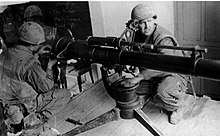M40 recoilless rifle
| M40 Recoilless Rifle | |
|---|---|
 Greek infantrymen with an M40 | |
| Type | Recoilless rifle |
| Place of origin | United States |
| Service history | |
| In service | Mid-1950s – present |
| Used by | See Users |
| Wars |
|
| Production history | |
| Manufacturer | Watervliet Arsenal |
| Specifications | |
| Weight | 209.5 kg (462 lb) |
| Length | 3.404 m (11 ft 2 in) |
| Height | 1.12 m (3 ft 8 in) |
|
| |
| Shell | 105×607mmR (HEAT, HEP, HEAP, Canister) |
| Caliber | 105 mm (4.1 in) |
| Recoil | Recoilless |
| Carriage | Tripod |
| Elevation |
−17° to +65° (between mount legs) −17° to +27° (over mount leg)[7] |
| Traverse | 360° |
| Muzzle velocity | 503 m/s (1,650 ft/s)[7] (M344 HEAT) |
| Effective firing range | 1,350 m (1,480 yd) |
| Maximum firing range | 6,870 m (M346A1 HEP-T)[8] |
The M40 recoilless rifle[9][10][11][12] is a lightweight,[13] portable, crew-served 105 mm weapon intended primarily as an anti-tank weapon made in the United States. The weapon is commonly described as being 106 mm, but it is in fact 105 mm; the 106 mm designation was intended to prevent confusion with the incompatible 105 mm ammunition from the failed M27.[14] It could also be employed in an antipersonnel role with the use of the antipersonnel-tracer flechette round. It can be fired primarily from a wheeled ground mount. The air-cooled, breech-loaded, single-shot rifle fired fixed ammunition. It was designed for direct firing only, and sighting equipment for this purpose was furnished with each weapon.
The earlier M27 recoilless rifle was a 105-mm weapon developed in the early 1950s and fielded in the Korean War. Although a recoilless rifle of this caliber had been a concept since the Second World War, the weapon was hurriedly produced with the onset of the Korean War. The speed with which it was developed and fielded resulted in problems with reliability caused by trunnions that were mounted too far to the rear. The M27 was also considered too heavy by the U.S. Army and had a disappointing effective range due to the lack of a spotting rifle. Taking the M27 as the basis for a new design, the Army developed an improved version of the M27 that was type-designated the M40 106-mm recoilless rifle in 1955.[15] Although unsuitable for military purposes, M27 recoilless rifles were used to trigger controlled avalanches at ski resorts and mountain passes in the United States.[16]
The M40 primarily saw action during the Vietnam War and was widely used during various conflicts thereafter in Africa or in the Middle East. It was replaced by the BGM-71 TOW anti-tank missile system in the US armed forces.
Description
The M40 is shaped like a long tube with an M8C .50 cal spotting rifle above. The spotting rifle fires a round whose trajectory closely matches that of the 105 mm round and gives off a puff of smoke on impact with the target. On the left side, there is an elevating wheel, in the center of which is the trigger wheel used to fine adjust the elevation and at the same time firing the spotting rifle when pulled, and the gun when pushed. The mounting is a tripod, but the front leg has a castering wheel. On top of the mount is a traverse wheel. On the center of the traverse wheel is a locking wheel, when the wheel is down, the rifle is locked in traverse, and can only be moved right and left with the traverse wheel. When the wheel is raised, the rifle can be traversed by hand. Austria produced a two-wheeled mount for the M40.
The whole mounting can be placed on an M151 Jeep for mobile use. It has also been mounted on M38A1 Willys Jeep, Land Rover Defenders, M113s, Mercedes-Benz G-Wagen, HMMWVs, Hotchkiss M201 jeeps, Toyota Land Cruisers, AIL Storms and M274 Mechanical Mules. They were also used on US Navy minesweepers (MSO) during Operation Market Time in Vietnam.
A special vehicle called the Ontos carried six M40s. A version specific to the T195E5 mount, the M40A1C, was used. It was used only by the U.S. Marine Corps. Japan produced a self-propelled gun called the Type 60, which carried two side by side. Some Pakistani M113s have a dual mounting. Three Panagopoulos coastal patrol boats class of the Hellenic Coast Guard and the Hellenic Navy in service of 1976-2003 was armed with two sextuples M40.[17]
The M40 was a very successful export item and continues to be used by South Korea (ROK), Ecuador, Egypt, Estonia, Greece, Honduras, Iran, Israel, Lebanon, Malaysia, Mexico, Morocco, the Philippines, Taiwan (Republic of China Marine Corps), Turkey, Colombia, Cambodia, Vietnam, Venezuela and many others, as well as anti-government forces in the Libyan Civil War and Syrian civil war.[18]
In the period 1958–1990, the antitank companies of the Swiss Army Infantry Regiments were equipped with 12 M40 guns.
It is manufactured in Iran by Defense Industries Organization as the ANTI-TANK GUN 106.[19]
Ammunition
Ammunition for the 105 mm rifle was issued as one-piece fixed cartridges. The term "fixed" means that the projectile and the cartridge case are crimped together. This ensures correct alignment of the projectile and the cartridge case. It also permits faster loading because the projectile and the cartridge case are loaded as one unit. The rear end of the cartridge case is perforated, to allow the propellant gas to escape through the vented breech, thus neutralizing recoil. Most projectiles (except HEAT) used are pre-engraved, that is, the rotating bands are cut to engage the rifled bore.[20] If the round was not rotated slightly when loading the M40 it could result in jamming in the breech.
Types of ammunition included HEAT, High Explosive Plastic-Tracer (HEP-T), canister, High Explosive Anti Personnel, and the M368 dummy round which could not be fired and was used for crew drill. The original U.S. HEAT round penetrated more than 400 mm of armor. Near the end of the M40's service life, both Austria and Sweden produced HEAT rounds for the weapon capable of penetrating more than 700 mm of armor.[21]
| Producer | Round name | Type | Proj Weight | Proj Filler | Filler weight | Armor penetration | Effective range |
|---|---|---|---|---|---|---|---|
| M581 | APERS | 9.89 kg | flechettes | 4.94 kg | N/A | 300 m | |
| M-DN11 | HEAP | 3.6 kg | Hexogen | 0.77 kg | N/A | 1500 m | |
| NR 160 | HEAT-T | N/A | N/A | N/A | N/A | N/A | |
| NR 483 | APERS | N/A | flechettes | N/A | N/A | N/A | |
| NR 601 | HESH-T | 7.8 kg | Comp. A3 | N/A | N/A | N/A | |
| PFF | HE | 9.89 kg | Comp. B | N/A | N/A | N/A | |
| M346A1 | HEP-T | 7.96 kg | Comp. A3 | 3.5 kg | N/A[22] | N/A | |
| M344A1 | HEAT | 7.96 kg | Comp. B | 1.27 kg | over 400 mm[23] | 1350 m | |
| 106 3A | HEAT-T | 5.5 kg | Octol | 1.0 kg | over 700 mm[24] | 2000 m | |
| RAT 700 | HEAT | 5.0 kg | N/A | 1.1 kg | over 700 mm | N/A |
Spotting Rifle
The ammunition for the M8C spotting rifle is not .50 BMG, but a round often refereed to as .50 BAT (Battalion Anti Tank), which is 12.7x77mm. .50 BAT was developed to replicate the trajectory of the 106 mm ammunition, and features a tracer element and a point-detonating incendiary filler to create a puff of smoke at the impact point.
Although the spotting rifle could conceivably be used in an antipersonnel role, historic U.S. military doctrine strongly discouraged this use, for a purely tactical reason—to conceal the vulnerable M40 and its crew from the enemy until the main rifle was ready to fire. However, this restriction is believed to be the source of a long-standing misconception that the laws of war restrict the use of .50-caliber projectiles against enemy personnel more generally.[25]
Users











































.svg.png)
















Gallery
 Greek Mercedes 240G M40 carrier. Note the metal guard to protect the engine from the gun blast.
Greek Mercedes 240G M40 carrier. Note the metal guard to protect the engine from the gun blast. Firing the gun from a Mercedes 240G
Firing the gun from a Mercedes 240G- An ex-Australian Army M40 recoilless rifle mounted on a Land Rover on display in the grounds of the Australian War Memorial
 A rather uncommon use of the M40 on a Greek fast patrol boat, circa 1982
A rather uncommon use of the M40 on a Greek fast patrol boat, circa 1982 The same Greek fast patrol boat
The same Greek fast patrol boat U.S. Marines manning an M40 during the Battle of Huế in the Vietnam War.
U.S. Marines manning an M40 during the Battle of Huế in the Vietnam War.
See also
References
Notes
- ↑ Higgins, David R. (20 Jan 2016). M48 Patton vs Centurion: Indo-Pakistani War 1965. Duel 71. p. 71. ISBN 9781472810922.
- ↑ ViperKnot (22 January 2014). "B10 Recoilless Rifle Shoots at Central Intelligence Building - Damascus" – via YouTube.
- ↑ "YouTube". www.youtube.com.
- ↑ "YouTube". www.youtube.com.
- ↑ "YouTube". www.youtube.com.
- ↑ "YouTube". www.youtube.com.
- 1 2 3 "Anti Tank weapons". official web site of the South African army. Retrieved 2011-05-08.
- ↑ U.S. Army Technical Manual 43-0001-28, p. 5-27, April 1994.
- ↑ "M40 - Weaponsystems.net". weaponsystems.net.
- ↑ "M40 RR 106mm Recoilless Rifle - United States".
- ↑ Pike, John. "M40 106mm Recoilless Rifle". www.globalsecurity.org.
- ↑ http://www.smallarmssurvey.org/fileadmin/docs/H-Research_Notes/SAS-Research-Note-55.pdf
- ↑ Bob Stoner GMCM (SW) Ret. (2005). "M40A1 106MM Recoilless Rifle with M8C Spotting Rifle".
- ↑ "M40 106mm Recoilless Rifle". globalsecurity.org. Retrieved 2012-09-20.
- ↑ John Weeks, Men against tanks, New York: Mason/Charter, 1975.
- ↑ Comment by Ken Estes at tanknet.org Archived 2013-05-27 at the Wayback Machine..
- ↑ WARSHIPS OF THE PAST: Panagopoulos class coastal patrol boats of the Hellenic Coast Guard and the Hellenic Navy, 18 January 2016
- ↑ McNally, Brendan (May 31, 2013). "Ancient U.S. Weapon Makes a Surprise Reappearance in Syria". Wired.
- ↑ ANTI-TANK GUN 106 Archived 2012-01-20 at the Wayback Machine.
- ↑ "M40 106mm recoilless Rifle". M40 106mm Recoilless Rifle. Global Security. Retrieved 27 January 2014.
- ↑ JAH, pp. 140-141.
- ↑ Probably defeats ~ 200 mm of armor.
- ↑ JIW.
- ↑ After penetrating explosive reactive armor.
- ↑ Parks, Maj W. Hays (January 1988). "Killing A Myth". Marine Corps Gazette. Retrieved 20 February 2014.
- ↑ Fitzsimmons, Scott (November 2012). "Callan's Mercenaries Are Defeated in Northern Angola". Mercenaries in Asymmetric Conflicts. Cambridge University Press. p. 139. doi:10.1017/CBO9781139208727.005. ISBN 9781107026919.
- 1 2 3 4 5 6 7 Small Arms Survey (2008). "Light Weapons: Products, Producers, and Proliferation" (PDF). Small Arms Survey 2008: Risk and Resilience. Cambridge University Press. p. 23. ISBN 978-0-521-88040-4.
- ↑ Ansar (26 May 2013). "World Military and Police Forces: Comoros".
- ↑ Army Recognition Alain Servaes. "Index of military army equipment from Salvadoran Army of El Salvador Index des équipements militaires de l'armée du Salvador Salvadorienne". Retrieved 13 February 2015.
- ↑ "sodur.com". Retrieved 13 February 2015.
- ↑ "YouTube". www.youtube.com.
- ↑ Small Arms Survey (2012). "Surveying the Battlefield: Illicit Arms In Afghanistan, Iraq, and Somalia" (PDF). Small Arms Survey 2012: Moving Targets. Cambridge University Press. p. 342. ISBN 978-0-521-19714-4.
- ↑ Gordon L. Rottman (2010). Army of the Republic of Vietnam 1955–75. Men-at-Arms 458. Osprey Publishing. pp. 7, 34. ISBN 9781849081818.
- ↑ Badri-Maharaj, Sanjay (2 February 2017). "Suriname's Armed Forces: Capability Compromised – Analysis". Institute for Defence Studies and Analyses.
- ↑ Green, Michael. "Weapons of the Modern Marines". Zenith Imprint – via Google Books.
Bibliography
- (JAH) Terry Gander and Ian Hogg (ed.), Jane's Ammunition Handbook 1994, Coulsdon: Jane's Information Group Ltd., 1993.
- (JIW) Richard Jones and Leland Ness (ed.), Jane's Infantry Weapons 2007–2008, Coulsdon: Jane's Information Group Ltd., 2007.
External links
| Wikimedia Commons has media related to M40 recoilless rifle. |